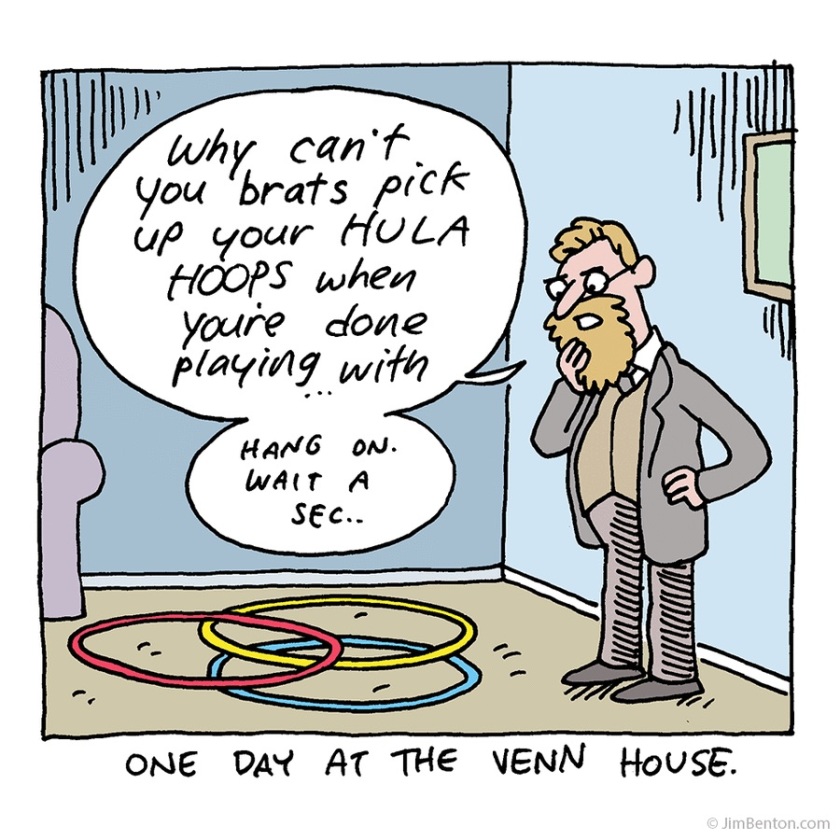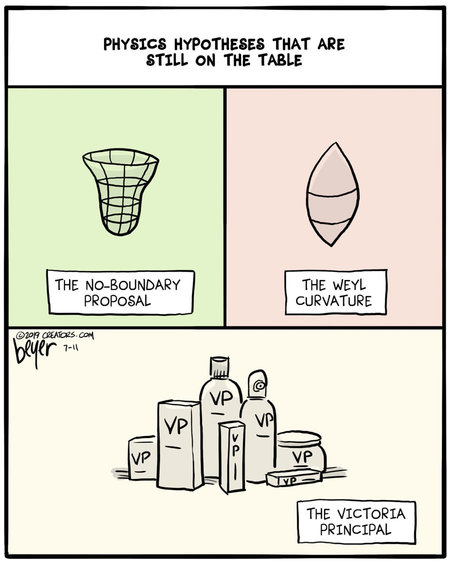I mentioned in my last Reading the Comics post that it seems there are fewer mathematics-themed comic strips than there used to be. I know part of this is I’m trying to be more stringent. You don’t need me to say every time there’s a Roman numerals joke or that blackboards get mathematics symbols put on them. Still, it does feel like there’s fewer candidate strips. Maybe the end of the 2010s was a boom time for comic strips aimed at high school teachers and I only now appreciate that? Only further installments of this feature will let us know.
Jim Benton’s Jim Benton Cartoons for the 18th of April, 2022 suggests an origin for those famous overlapping circle pictures. This did get me curious what’s known about how John Venn came to draw overlapping circles. There’s no reason he couldn’t have used triangles or rectangles or any shape, after all. It looks like the answer is nobody really knows.
Venn, himself, didn’t name the diagrams after himself. Wikipedia credits Charles Dodgson (Lewis Carroll) as describing “Venn’s Method of Diagrams” in 1896. Clarence Irving Lewis, in 1918, seems to be the first person to write “Venn Diagram”. Venn wrote of them as “Eulerian Circles”, referencing the Leonhard Euler who just did everything. Sir William Hamilton — the philosopher, not the quaternions guy — posthumously published the Lectures On Metaphysics and Logic which used circles in these diagrams. Hamilton asserted, correctly, that you could use these to represent logical syllogisms. He wrote that the 1712 logic text Nucleus Logicae Weisianae — predating Euler — used circles, and was right about that. He got the author wrong, crediting Christian Weise instead of the correct author, Johann Christian Lange.

With 1712 the trail seems to end to this lay person doing a short essay’s worth of research. I don’t know what inspired Lange to try circles instead of any other shape. My guess, unburdened by evidence, is that it’s easy to draw circles, especially back in the days when every mathematician had a compass. I assume they weren’t too hard to typeset, at least compared to the many other shapes available. And you don’t need to even think about setting them with a rotation, the way a triangle or a pentagon might demand. But I also would not rule out a notion that circles have some connotation of perfection, in having infinite axes of symmetry and all points on them being equal in distance from the center and such. Might be the reasons fit in the intersection of the ethereal and the mundane.

Daniel Beyer’s Long Story Short for the 29th of April, 2022 puts out a couple of concepts from mathematical physics. These are all about geometry, which we now see as key to understanding physics. Particularly cosmology. The no-boundary proposal is a model constructed by James Hartle and Stephen Hawking. It’s about the first seconds of the universe after the Big Bang. This is an era that was so hot that all our well-tested models of physical law break down. The salient part of the Hartle-Hawking proposal is the idea that in this epoch time becomes indistinguishable from space. If I follow it — do not rely on my understanding for your thesis defense — it’s kind of the way that stepping away from the North Pole first creates the ideas of north and south and east and west. It’s very hard to think of a way to test this which would differentiate it from other hypotheses about the first instances of the universe.
The Weyl Curvature is a less hypothetical construct. It’s a tensor, one of many interesting to physicists. This one represents the tidal forces on a body that’s moving along a geodesic. So, for example, how the moon of a planet gets distorted over its orbit. The Weyl Curvature also offers a way to describe how gravitational waves pass through vacuum. I’m not aware of any serious question of the usefulness or relevance of the thing. But the joke doesn’t work without at least two real physics constructs as setup.

Liniers’ Macanudo for the 5th of May, 2022 has one of the imps who inhabit the comic asserting responsibility for making mathematics work. It’s difficult to imagine what a creature could do to make mathematics work, or to not work. If pressed, we would say mathematics is the set of things we’re confident we could prove according to a small, pretty solid-seeming set of logical laws. And a somewhat larger set of axioms and definitions. (Few of these are proved completely, but that’s because it would involve a lot of fiddly boring steps that nobody doubts we could do if we had to. If this sounds sketchy, consider: do you believe my claim that I could alphabetize the books on the shelf to my right, even though I’ve never done that specific task? Why?) It would be like making a word-search puzzle not work.
The punch line, the blue imp counting seventeen of the orange imp, suggest what this might mean. Mathematics as a set of statements following some rule, is a niche interest. What we like is how so many mathematical things seem to correspond to real-world things. We can imagine mathematics breaking that connection to the real world. The high temperature rising one degree each day this week may tell us something about this weekend, but it’s useless for telling us about November. So I can imagine a magical creature deciding what mathematical models still correspond to the thing they model. Be careful in trying to change their mind.
And that’s as many comic strips from the last several weeks that I think merit discussion. All of my Reading the Comics posts should be at this link, though. And I hope to have a new one again sometime soon. I’ll ask my contacts with the cartoonists. I have about half of a contact.
One thought on “Reading the Comics, May 7, 2022: Does Comic Strip Master Command Not Do Mathematics Anymore Edition?”